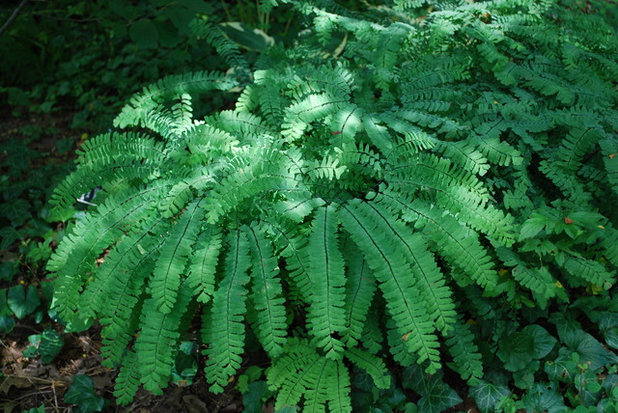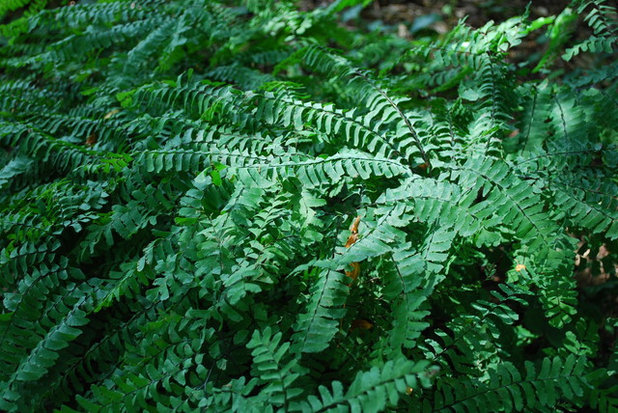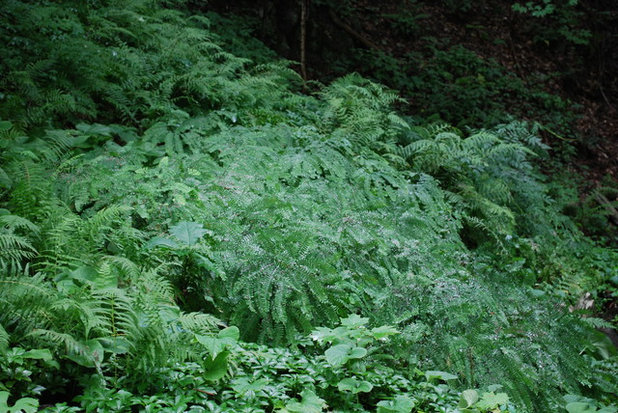A successful shade garden relies more on textures and shapes than perhaps any other type of garden. In shady nooks, where a profusion of blossoms is rare and almost an unwelcome intrusion into serenity, ferns rule the roost. While some fern species have long, spiky fronds to add structure and lift the eye, maidenhair ferns (
Adiantum pedatum) add softness and romance. Used from Victorian times to the present as houseplants, some species are North American natives that can elicit the same emotions and memories that your grandmother’s potted maidenhair did while sitting atop her antique piano.
Let’s take a look at the northern maidenhair fern.

Jay Sifford Garden Design
Botanical name: Adiantum pedatumCommon name: Northern maidenhair fern
Origin and range: Eastern North America
Where will it grow: Hardy to -40 degrees Fahrenheit (USDA zones 3 to 8;
find your zone)
Water requirement: Moist soil; while some fern species can tolerate semidry conditions, do not allow this fern to dry out
Light requirement: Partial to full shade
Soil requirement: Consistently moist, rich soil amended with organic matter

Jay Sifford Garden Design
Mature size: 1 foot to 2 feet tall and wide
Benefits and tolerances: This fern tolerates acidic soil, deep shade and wet feet; it’s disease and pest resistant
Seasonal interest: The northern maidenhair fern celebrates spring by pushing up soft, new fronds in midspring that are pink; by summer it sports soft, billowy fronds that seem to take the edge off hot, seemingly endless summer days; as long as it receives enough moisture and shade, the display will continue until the frost.
When to plant: Spring or fall is best; summer is fine as long as this fern is planted in moist shade
Distinguishing traits. The northern maidenhair fern is a clumping fern with fronds that cascade downward, as opposed to its vase-shaped or erect cousins. It differs from its southern counterpart in that it sports palmate fronds, or fronds divided into finger-like projections, giving the frond an umbrella-like shape. Its narrow stems are reddish brown to black. Unlike some other ferns, this clumping fern is a slow spreader, spreading by underground rhizomes as well as spores in very moist, humid environments.

Jay Sifford Garden Design
How to use it. The northern maidenhair fern shows best planted en masse in a woodland setting. It produces a wonderful and visually soothing display if planted on a creek bank or up the sides of a moist ravine, as shown in this photo from Innisfree Garden. Dare to show off its unique texture by pairing it with mass plantings of more erect ferns with a coarser texture or with the large-leaved Rodgersia (
Rodgersia spp
, zones 5 to 7). Lenten roses (
Helleborus orientalis, zones 4 to 9), with their darker green palmate leaves, provide a peaceful case study in juxtaposition when adjoining these ferns in the woodland garden.
Planting notes. The northern maidenhair fern does best planted in moisture-retaining soil full of decayed organic matter. Adding some mushroom compost and composted cow manure to the hole at the time of planting will greatly benefit this fern.
More: Ferns: A Shade Gardener’s Best Friend





